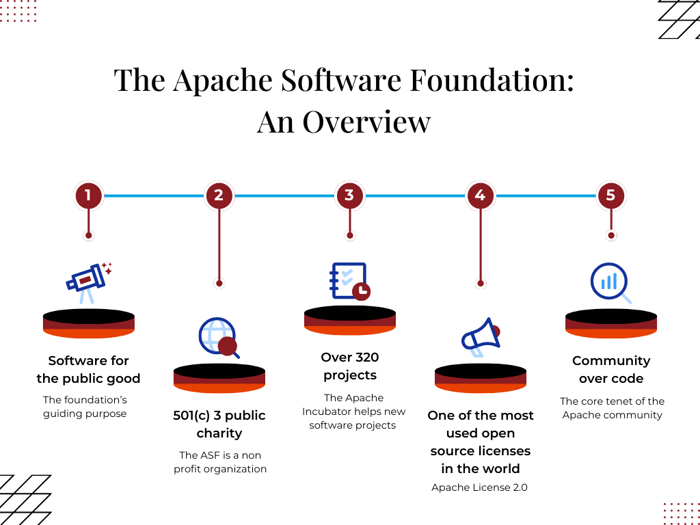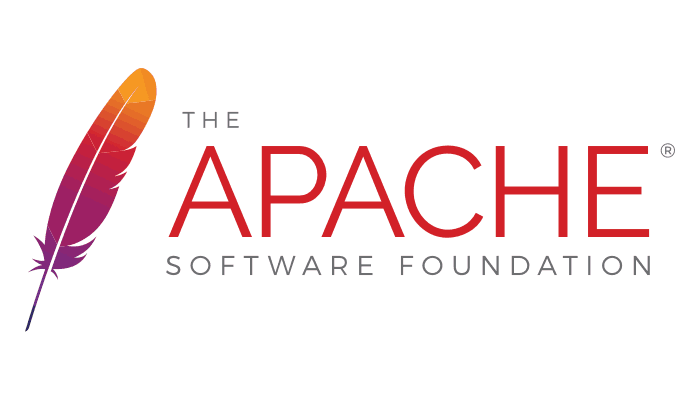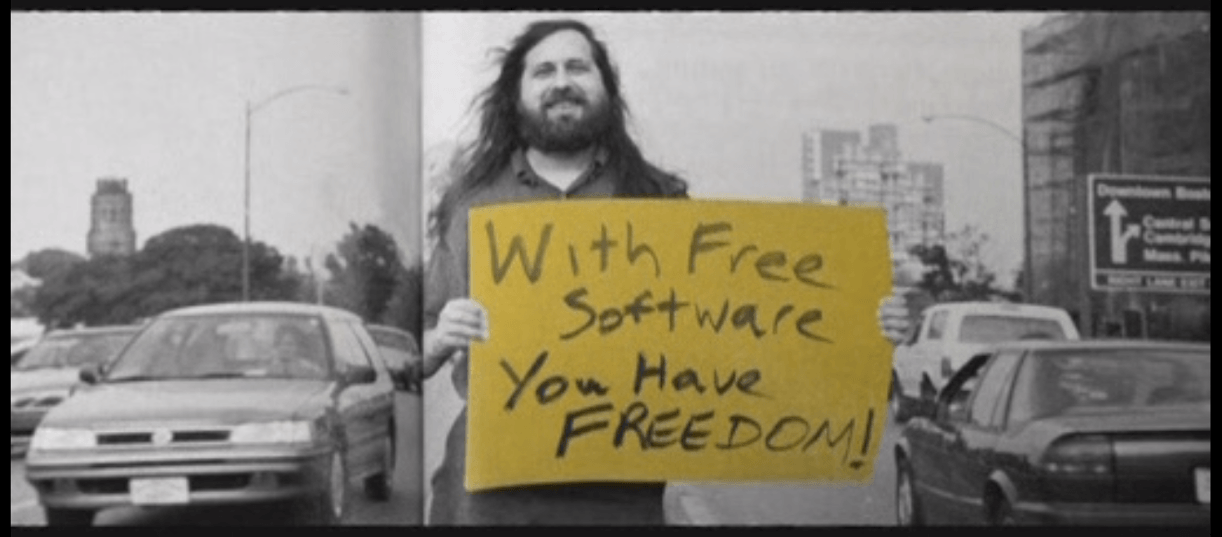What is the Apache Software Foundation?
The Apache® Software Foundation is a 501(c) 3 public charity organization whose mission is to create and make available software for the public good. It was formed in 1999 to provide a foundation for open, collaborative software development projects by supplying hardware, communication, and business infrastructure, as well as one of the most popular open source licenses in the world. The ASF currently has 320 active projects under their umbrella, provides resources for new projects via the Apache Incubator, and the entire foundation is volunteer run.
A little history
The origins of the ASF begin in 1999, when a group of developers came together to continue to support and maintain the HTTPD web server written by the NCSA (National Center for Supercomputing Application). This was a web server released in 1993 and initially developed at The University of Illinois Urbana-Champaign by Robert McCool and others as one of the earliest open source web servers ever developed.
At some point, the original developers lost interest in the project and essentially left all the people who had been using and working with this server with no support. So the users started to exchange “patches,” which are fixes, as well as other information that helped to prevent problems and continued to make the existing software better.
One of those collaborators, Brian Behlendorf, created a mailing list on his computer for users to use as a communication channel to better collaborate on fixes, maintenance and improvement of the NCSA software. This mailing list eventually coalesced into a group that called itself “Apache.”
Why the name Apache?
While some say the name "Apache" was chosen out of admiration for the Native American Apache Nation, the real reason is that the project's roots started with users sharing fixes or “patches.” When all was said and done, you could say it was a bit of a-patchy server. And so the name was born.
The group continued working on their open source server and between 1995 and 1999, their Apache HTTPD Web Server became the market leader--and still is. More than 65% of all websites in the world are powered by it. As the web grew, the Apache website started hosting new sister projects like Apache OFBiz®.

What makes the Apache Software Foundation different?
The guiding principle that sets the ASF apart from others is that its projects must serve the greater public good. The analogy that is so often used to describe this at Apache is the sandbox. Basically, think of the code as a giant sandbox, with many smart people playing in that box. With open source, instead of everyone claiming a corner and making their own castle, they come together and build a huge, impressive, really cool castle as one group.
Open source software is software that's released under a specific kind of license that makes its source code legally available to end-users. This openness creates an unmatched possibility for continuous innovation and customization, since the source code used for any particular project can be further built upon to meet the individual needs of whatever business or organization is using it.
Note: the code for the final project is not freely available and thus cannot be tampered with or changed at will by the public. Rather, the building blocks (in the form of source code), are what's available and gives a head start to teams using it.
What makes the Apache sandbox so unique is that it wasn’t created by one person who lords their proprietary creation over others. Rather, the Apache web server was started by a diverse group of people who shared a common interest; they wanted to make the server better. That ethos is still alive today and can be witnessed most notably in the greater Apache community.
The Community
Each ASF project has its own community that provides advice, fixes, and opportunities to network with other developers and find help if you're just starting out or looking for resources related to your open source software system. Because the ASF is volunteer run, project members choose to take time out of their lives and give freely of their knowledge for the good of the project, the betterment of the community, and the advancement of open source software.
In the documentary Trillions and Trillions Served, Greg Stein, former ASF chairman, speaks about developers as artists; artists thrive in a community. A place where ideas, images, performances, and emotions are shared and made better by the collaborative process. The same goes for Apache.
The Apache Way
The core tenet of The Apache Way is, Community Over Code.
“If you build a vibrant, self-governing, self-sustaining community, your code will come. It doesn’t work the other way around.” – Roman Shaposhnik, ASF Member
One of the main ways this is put into practice throughout the organization and community is asynchronous communication via mailing lists. This is because asynchronous communication allows for equality in participation. No one is disenfranchised because everyone involved, even peripherally, is part of the communication and has an equal opportunity to participate.
A study published in the Harvard Business Review found that it's not uncommon for workers to spend 80% of their time communicating with co-workers, usually via email or some other form of synchronous communication. Asynchronous communication is less disruptive to a worker’s day and more productive in terms of answers and information given.
Another aspect of the Apache way is working in a meritocracy. Power, so to speak, at Apache is bestowed on individuals based on talent, effort, and achievement, not on the basis of money or social class. This means the seat of power is constantly changing, no one occupies it for an endless amount of time, and it's always earned. In short, it isn’t about who you are; it's very much about what you do.
.png?width=700&height=525&name=The%20Apache%20Software%20Foundation%20An%20Overview%20(2).png)
HotWax, OFBiz™ & Apache
For us at HotWax, the Apache community is vital because the ASF is the governing body of OFBiz™, the open source web framework that we use.
Our CEO, Mike Bates, is featured in the documentary Trillions and Trillions Served. Several Hotwax employees are OFBiz Project Management Committee (PMC) members. And Hotwax’s CTO, Jacopo Cappaleto, is the VP of the OFBiz project.
Additionally, in the spirit of the Apache Way, one Saturday a month, we have a community OFBiz day where several employees spend the day volunteering their immense software development skills to make the OFBiz project better. They work fixing bugs, completing tickets, etc. We’ve done this for many years, and you can see our contribution in the metric on our homepage.
We also continue to be a top sponsor of Apachecon.
Apachecon
Apachecon, hosted by the ASF and now called Community Over Code, is one of the original open source conferences.
The first event was held in October of 1998 for three days at the Hilton in San Francisco, with just under 500 people in attendance. Most came from the U.S. and Canada, however, there was a significant showing of people from Europe. In addition to the general conventioneers, most of the core 18 Apache developers were there as well. Some of the speakers included John Gilmore of EFF, John Patrick of IBM and David Filio from Yahoo, with the final session of the conference featuring the core developers of Apache.
Apachecon continues to this day. Attendees have access to participants at all levels, from presenters and sponsors to Apache Project Management Committee members, ASF leadership, and more in a collaborative, vendor-neutral environment.
Community over code
At the heart of Apache is a deep and practical commitment to the creation and maintenance of software for the public good. Through its mailing lists, conferences, the Apache Incubator, and the many robust Apache projects and associated communities, the ASF makes available robust open source software and resources for individuals and enterprises across the globe.
.png?width=700&height=525&name=The%20Apache%20Software%20Foundation%20An%20Overview%20(3).png)







